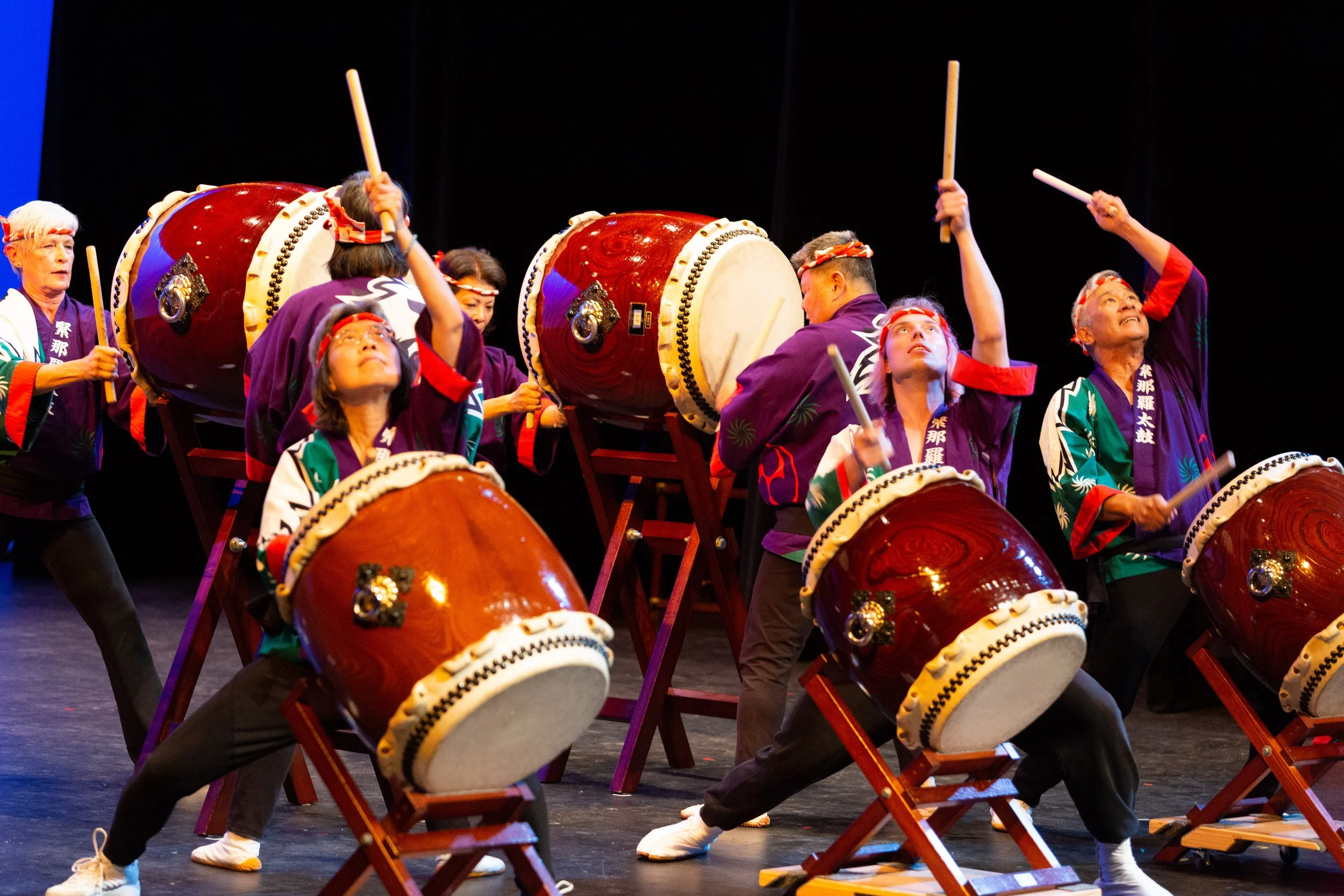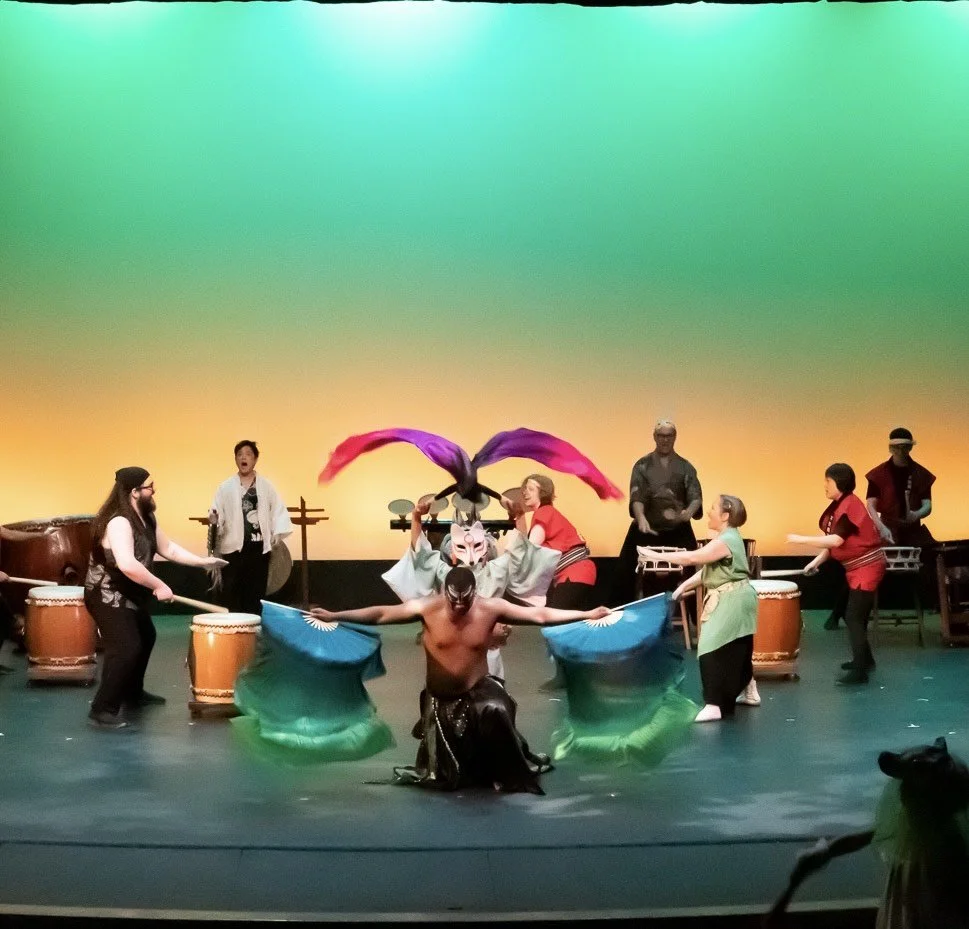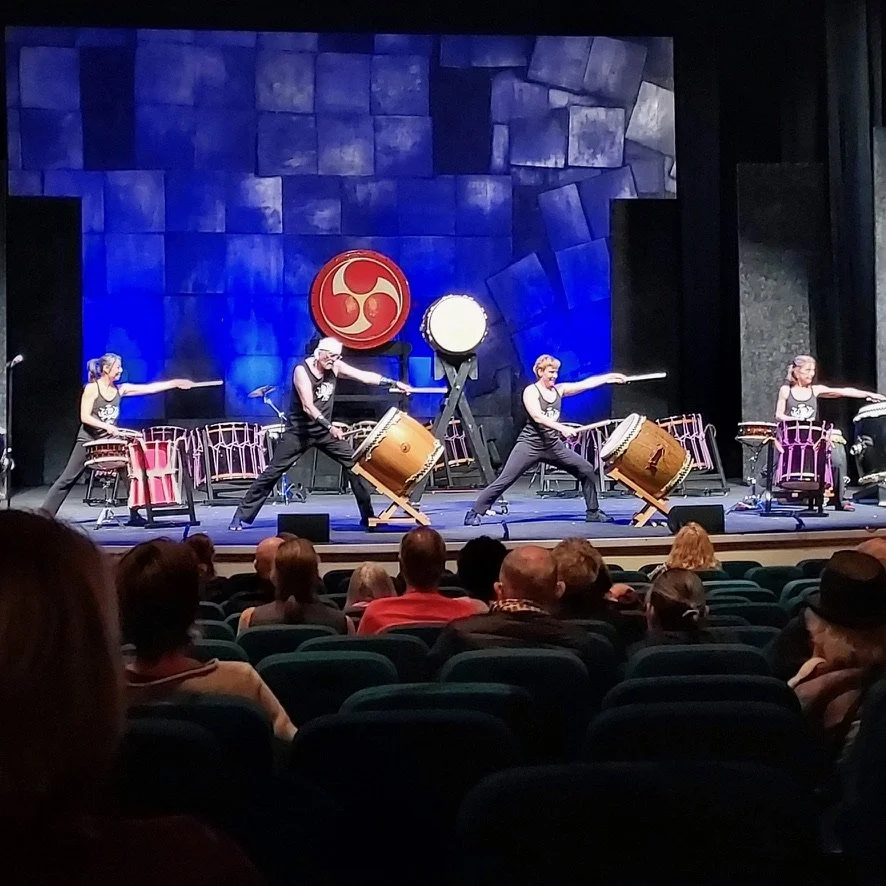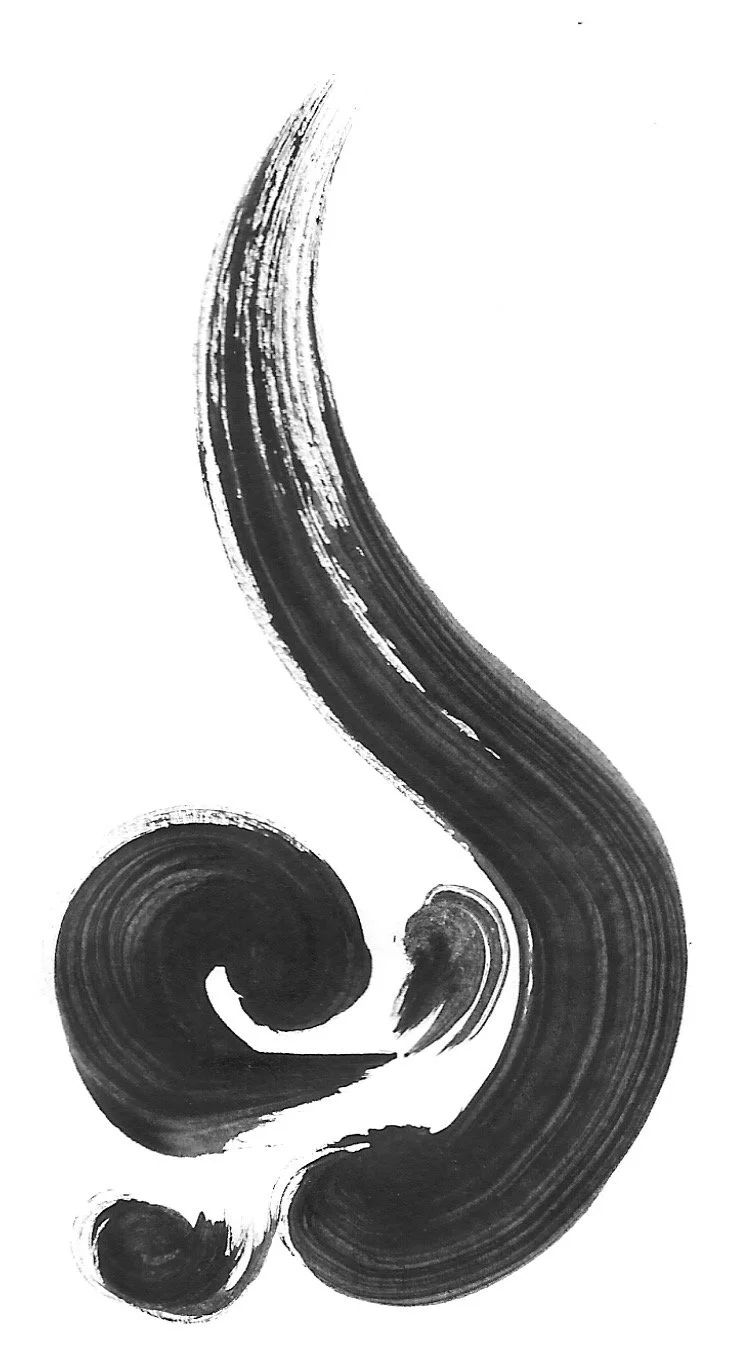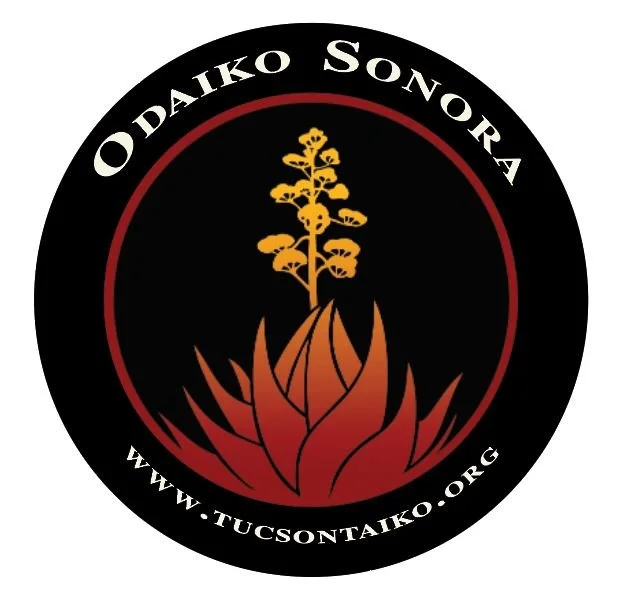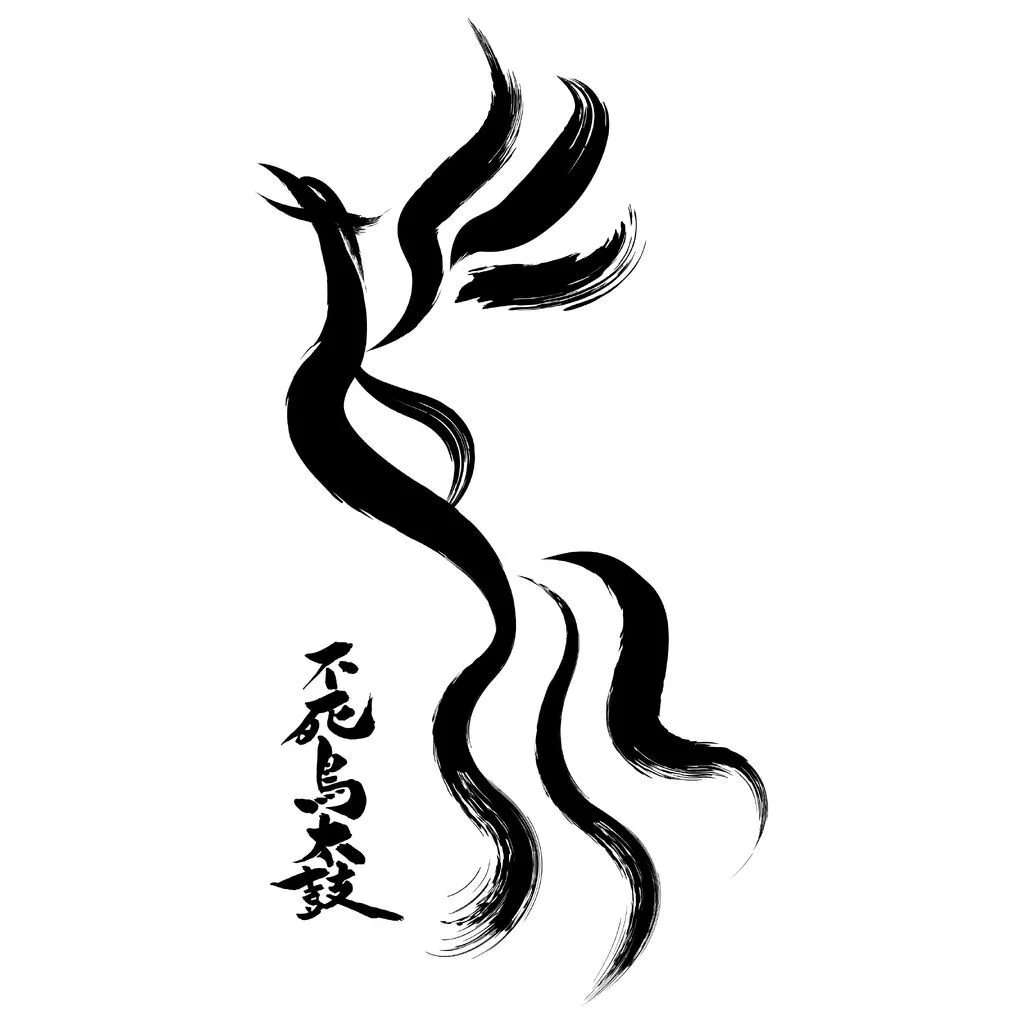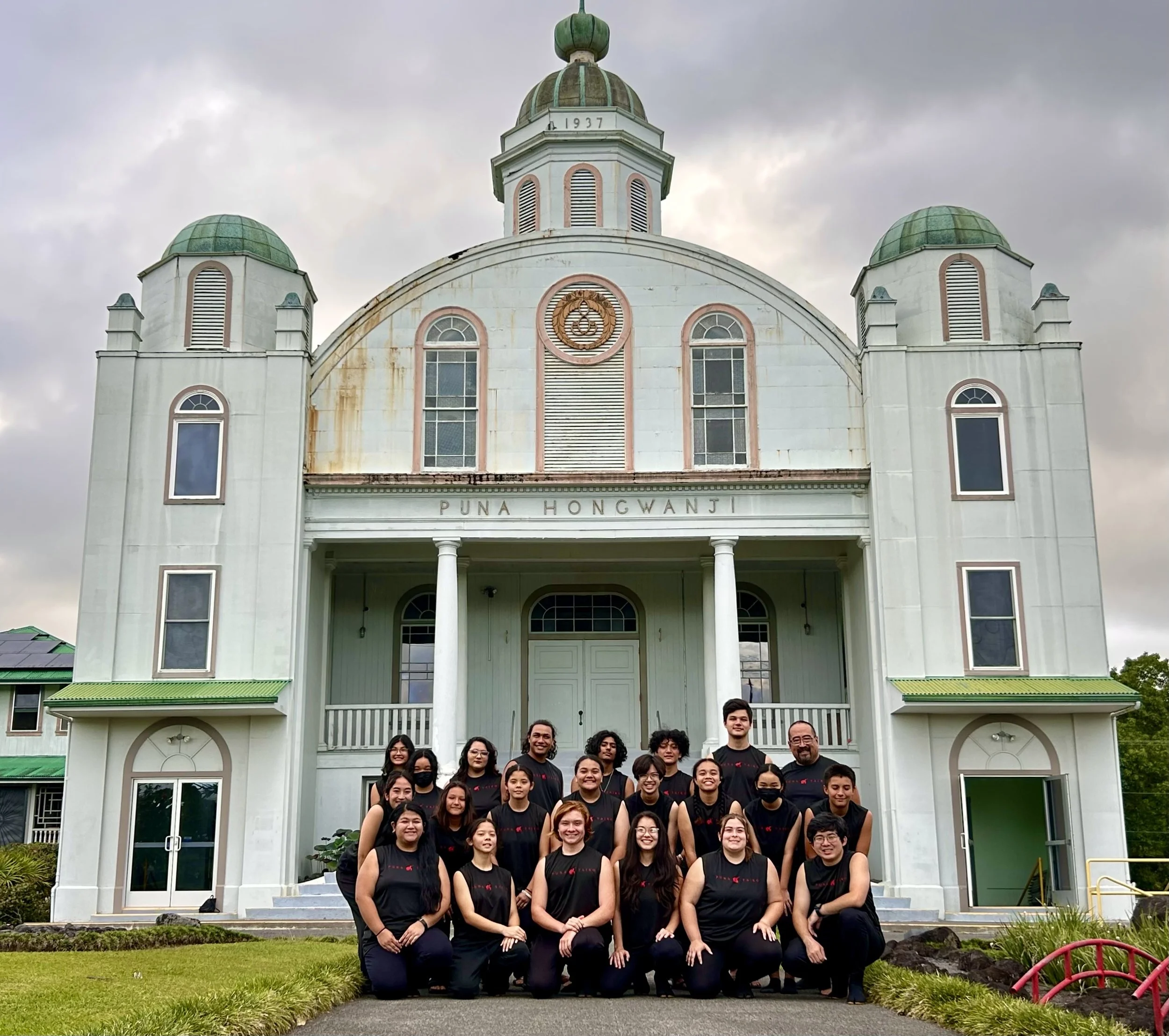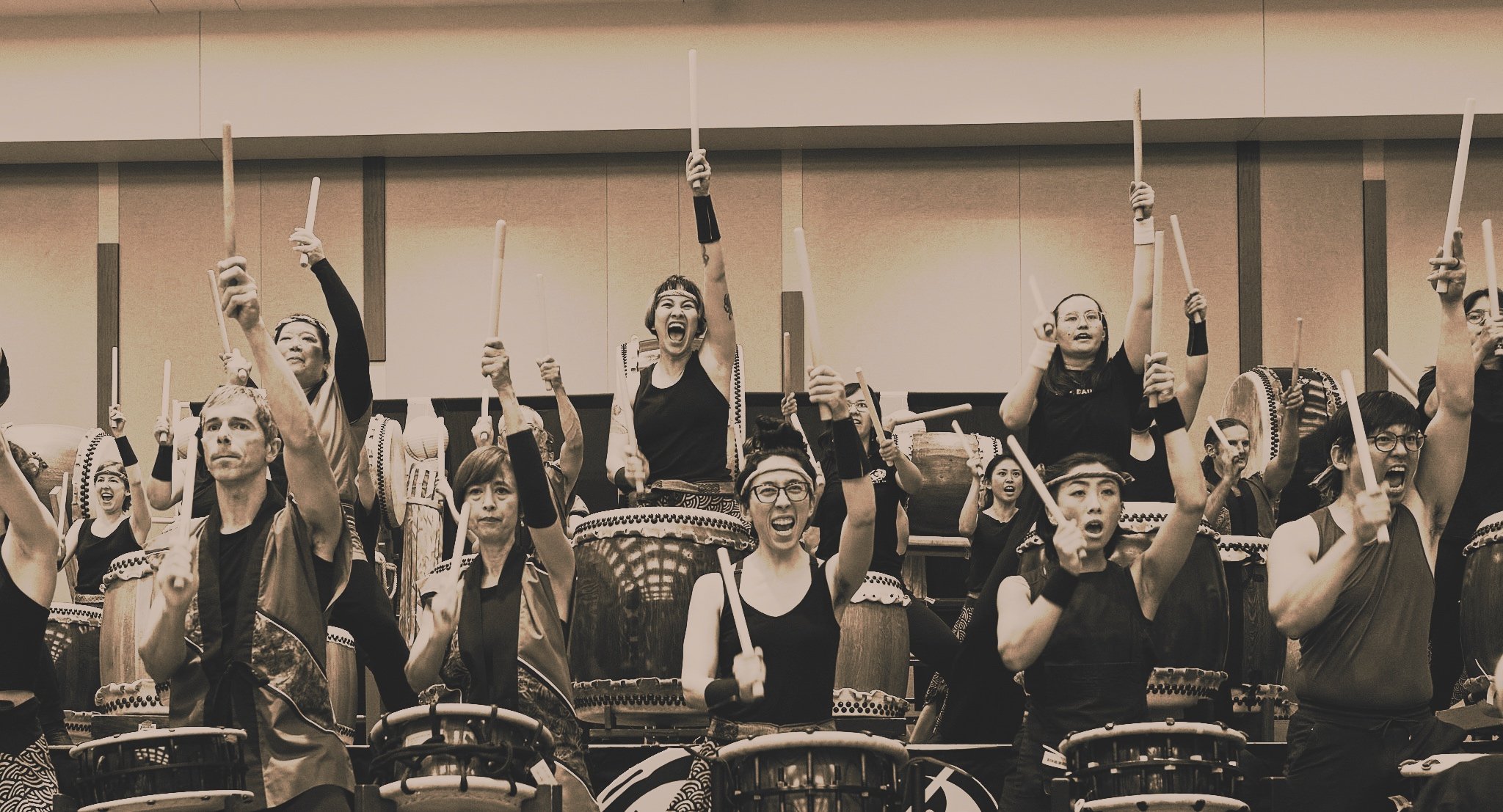
2025
NORTH AMERICAN TAIKO CONFERENCE
Phoenix, AZ
OTSUKARESAMA DESHITA!
Thank you for an amazing conference!

Thank you to our 2025 NATC Sponsors and Partners!
Drummers’ Circle
NATC Phoenix was made possible through the generous support of our donors, who established critical seed funding for the project. The Drummer’s Circle is a NATC tradition that recognizes and celebrates these individuals. After seven years and a global pandemic, the North American Taiko Conference is back thanks to the love, dedication, and generosity of the taiko community. We recognize the following Drummers’ Circle for their persistent support, empowerment, and dedication to the art of taiko.
Alexa Riner, Andy Jones, Elena Moschell, Heather McLean, Helen McMillin, Holly Johnson, Kate Meigneux, Lika Seigel, Marinda Chen, Melia Okura, Merle and Alan Okada, Neil Fajardo, Reiko Mitsunaa, Rita Sauer, Ron Miyamura, Samar Aljishi, Scott Kujiraoka, Stanley Shikuma, Tan Tran, Therese Stephen, Wendy Jedlicka, and Yasuko Kujiraoka.
Okagesama De.

Taiko Jam
Sunday, August 31st
7:30PM
Taiko Jam Team
Production Manager- Sarah Ayako
Concert Director- Nicole Stansbury
Technical Director- David Cheetham
Venue Liaison- Ava Kovlakas
PERFORMING GROUPS
Makoto Taiko strives to connect and empower people of all backgrounds by advancing the practice of taiko with intention and sincerity.
Exodus
Composed by Patrick Cruz
Performed by Makoto Taiko Youth Ensemble
"Exodus" is a symbolic piece that represents the idea of leaving your home, struggling through your journey, and eventually succeeding in finding your new home.
Sandou 山道
Composed by Hunter Loyd
Performed by Hunter Loyd and Patrick Cruz
Sandou which translates as "mountain road" or "the way of the mountain," evokes a journey down a steep mountain path.
Kanpai!
Composed by Isaac Caldas
Performed by Makoto Taiko Performance Group
Kanpai! is a celebration of a job well done. The song depicts a lively gathering of dear friends and follows them through a day of music making, storytelling, and sharing in the joy of taiko.
Memories 思い出
Composed by Patrick Cruz
Performed by Makoto Taiko Performance Group
Based on Cruz's Taikai-winning original composition "Letter to my Childhood," this ensemble rendition narrates key moments of each soloist's journey as a taiko performer--from their first exposure to where they are now
Makoto Taiko
Fushicho Daiko is Arizona's premier and longest running professional performing Taiko group. Through performances, workshops, residencies, and regularly scheduled classes, Taiko is alive and well in the Southwest. We pride ourselves on inclusion and diversity; our mission is to share the passionate energy and unique harmony of Taiko drumming to all who wish to be inspired by this dynamic and powerful art form.
“Ranbu” 乱舞, written by Fukushima, Ranbu is a staple of the Fushicho Daiko repertoire. A great introduction to all the different sounds of the Taiko and auxiliary instruments. It is a fun and interactive song that engages all ranges of audiences, from the very young, first learning about Taiko, to the seasoned veterans of Taiko who can appreciate a good comedic battle.
"Fuchi Confusion", written by Marsha Robb
Taiko conveys the full life expression of the physical, mentally, spiritual and emotional journey of a person. Fuchi Confusion expresses the antithesis, the opposite. When you experience the sharp contrast of the lifelessness of this song, it brings into keener focus the importance of what makes Taiko truly dynamic and powerful.
“Hono Daiko”, indigenous song from Hiroshima, taught to Fushicho Daiko by Munakata Osamu Sensei of Hiroshima Taiko Hozonkai.
Dating back over a thousand years, this song originated as a prayer to the guardian deities, performed by hermit priests in small mountain shrines. It is played now at festivals and any happy occasion. Of all the pieces, it is the one which best displays the rhythmic synchronization of the group – six or more taiko players in perfect harmony, led by the deep mellow tones of the horagai/conch shell and driven by the bright sounds of the chappa.
“Kachidoki”, written by Hatanaka Kenzo in 1979.
Originally trained in western music and brass bands, Hatanaka was commissioned by the city of Matsuyama to write a cycle of songs celebrating the founding of Matsuyama City. His 5 song set honors the Navy of the Kono clan, a feudal family that began as pirates but evolved into a kind of coast guard of the region, playing crucial roles in protecting and regulating the Seto Inland Sea and specifically the Matsuyama/Iyo area. “Kachidoki”, Victory celebrates the power and success of the Iyo no Kuni Suigun Navy in protecting their strongholds. Using old Japanese language to call all together, the song uses some of the indigenous rhythms that were included in sacred celebrations of Matsuyama.
Special Guest: Karen Falkenstrom and Odaiko Sonora of Tucson
Fushicho Daiko Dojo
Ken Koshio is a Japanese-born musician, taiko drummer, and cultural ambassador based in Phoenix, Arizona. Originally from Nagoya, Japan, he began his career as a singer-songwriter and folk-rock performer before moving to the U.S. in the late 1990s. His journey led him to discover taiko drumming, which became the heart of his artistic expression.
Through his performances, Ken blends traditional Japanese culture with global influences, creating powerful experiences that emphasize peace, unity, and connection. He founded his Wa-Konkan Dojo, a cultural center in Phoenix, where he teaches taiko, origami, calligraphy, and other Japanese arts to share heritage with future generations.
Koshio Gumi is a Phoenix-based intergenerational taiko drumming ensemble founded and led by Ken Koshio. The group brings together individuals from diverse cultural, professional, and geographic backgrounds, united by the powerful rhythms of traditional Japanese taiko drumming. More than a performance ensemble, Koshio Gumi serves as a cultural community dedicated to fostering peace and connection through music.
“Kokoroiki” (心意気) is an original piece composed by Ken Koshio. Kokoro (心) means “spirit” or “heart,” while iki (意気) means “determination” or “willpower.” This signature piece for Ken Koshio and Koshio Gumi embodies the spirit of each performer and creates powerful rhythmic unity.
“Hiroshima Nicho Daiko” (広島二丁太鼓) is one of the traditional jidaiko (indigenous taiko drum) pieces preserved by the Hiroshima Taiko Preservation Society (Hiroshima Taiko Hozon Kai), founded in 1964 to safeguard centuries-old rhythms from Hiroshima Prefecture. Passed down to us by our sensei, Itsuki Munakata—a survivor of the Hiroshima bombing—this piece embodies both resilience and renewal, honoring the past while beating for peace today.
Koshio Gumi
The All Souls Procession Finale is a collaborative piece that unites taiko, dance, and circus arts to express the ferocity and joy of life in the desert — from the thunderous monsoon rains to the darting flight of birds, the yipping coyotes to the people who are the heart of our community. As the name suggests, this piece was designed as the finale performance of the 2024 All Souls Procession, an annual public ceremony in which hundreds of thousands of people gather to walk together and grieve those they have lost through art, music, and movement.
Pulling Down Clouds - by Karen Falkenstrom
Vermillion - by Nicole Stansbury
Mochizuki - by Aki Takahashi
All Souls Procession Finale
San Jose Taiko creates innovative performances and comprehensive educational programs, empowering diverse voices and educating across cultures to build a more accepting and ENGAGed world.
1. Home Coming Home by Alex Hudson, 2016
5th and Jackson; one stop before Machida station on the Odakyu line; past the Ice Palace at the Aloha Stadium exit; a nearby pond that sings with ducks and frogs before running to the Willamette. Our real, true home, our heart, the people who lift us up and make us better. The home we know we’ll return to someday, and the home we carry with us always.
2. Wagamama by Yurika Chiba, 2016
“Wagamama” is usually translated as “willful or naughty child". This song plays on the composer’s confusion growing up Japanese Canadian, as to when to blend in or disappear and when to stand out. Other themes addressed are formality/informality and “honne”/"tatemae" (honesty/facade). Special thanks to Kelli Wing, Craig Wong, and Byron Yamanaka, who contributed childhood secrets for the formulation of rhythmic patterns in the piece.
3. Chikara by Janet Koike, 1995, arranged with poetry by Franco Imperial, 2023
“Although I am imprisoned, My heart and mind are free.” This poem, written by Shiro Fujioka during internment in Heart Mountain camp, inspires Chikara, an internal strength that keeps the human spirit alive. The poetry read aloud comes from the “Tachibana Ginsha” (Standing Flower Poetry Group), a collective of Issei individuals confined at Heart Mountain, with the composer’s grandfather being one of its members. Special thanks to Janet Koike for generously sharing this collection with us.
4. Tales of a Balloon by Mitchell Fukumoto, 2012, arranged 2024
A little red balloon floats blissfully away in the distance. Where did it come from and who set it free? “Tales” recalls the whimsical and carefree nature of one’s childhood. Awaken your inner child and relive those careless days once again. What tales would your balloon tell? “Tales” is a rearrangement of a piece originally composed for Stanford Taiko.
5. Beyond by Geoff Noone, 2023
Celebrating 50 years of rhythm and community, “Beyond” honors San Jose Taiko’s legacy of contemporary taiko music, while propelling its voice forward. With an energetic drive towards new horizons, “Beyond” invites audiences to share in a hopeful vision of the future.
San Jose Taiko

Taiko Ten
Saturday, August 30th
7:30PM
Taiko Ten Team
Production Manager- Sarah Ayako
Technical Director- David Cheetham
Concert Director- Nicole Stansbury
Venue Liaison- Ava Kovlakas
PERFORMING GROUPS
Torii Taiko
Torii Taiko cooks up a contemporary blend of dance, aikido, drumline, Afro-Cuban, and rock and roll influences, to make some taiko gumbo. They strive to honor the spirits of place, open hearts with their bachi, and move in practice, patience, and passion. Torii Taiko invites you to cross joyfully over to worlds beyond our everyday existence. Leave the mundane behind, search for the extraordinary, and dance!
In that spirit, you’ll first hear Mozambique (MO_ZAM_B_K) In 1965, Pello (PAYO) El Afrokan’s Cuban dance craze Mozambique peaked. But the rhythm lived on in other versions, including the closing number from British rock band Traffic’s final studio album. That’s where Torii Taiko’s Jon Whitsell fell in love with it; add some sizzle from the two dancers and drumline aikidoka, and you have Mozambique, Torii Taiko style.
The composer of the second piece says that as a young girl, she always heard, “ can you speak up?” and, “ I can’t hear you.” But standing in front of an Odaiko for the first time, she was inspired to embody the strength and depth of its sound. This original piece from Dyan Yoshikawa and Torii Taiko is titled: Can You Hear Me Now?
Mujō Dream Flight
MDF is the artistic vehicle of founding taiko artists Sasen Cain, Yeeman “ManMan” Mui, and Maxyn Rose Leitner. Together, and in collaboration with other predominantly trans/non-binary taiko artists, they create both original works and traditional adaptations. MDF’s art centers dance and personal storytelling informed by their specific cultural backgrounds.
Ojai O’Daiko
Ojai O’Daiko was founded in 2017 by Artistic Director, Gavino Takase-Sanchez. The group blends traditional drumming techniques with innovative, contemporary styles. They embody a culture of collaboration, mutual respect, and trust, fostering an environment where creativity and innovation thrive
The piece they’ll play for you today, Kurui Daiko, was composed by Gavino Takase-Sanchez. Originally created in the early 2000’s, Kurui Daiko has since evolved into a visceral sound that integrates elements of North Indian classical music and West African rhythms. It has grown into a composition that feels alive, feral and unrestrained. It no longer seeks to express. It seeks to invoke. Enjoy the power of Kurui Daiko!
Lani Villanueva
From the islands to the desert (and across the street at Saboten-Con), Lani "Supa Lani-Chan" Villanueva (she/they) is an entertainer, multi-instrumentalist, vocalist, and music educator. Their taiko career started a little "backwards" where they actually played the video game "Taiko no Tatsujin" first (along with their obsession with Dance Dance Revolution!) and then they started playing for real in June 2013 as a community group member of Odaiko Sonora. In 2018, Lani moved back to Hawaii where they trained and became a performing member of The Kenny Endo Taiko Ensemble and an instructor for Taiko Center of the Pacific.
Lani came back to Tucson Arizona in 2021 where they now teach band, choir, and general music at a K-8 school, serve as Managing Director of Tucson's comedy musical group "One Rehearsal Short", and provide music/vocals as a member of the cartoon-inspired music trio "The Key Frames." When Lani is not busy with music, they're either watching cartoons/anime, playing games on their switch, meditating, or napping!
Odaiko Sonora
Odaiko Sonora is from Tucson, AZ. Their performance today shares two pieces to honor the life and memory of Margaret “Hop” Hopkins. Hop was a founding member of Moab Dan and as anyone who met her will attest, she lived life to its fullest and encouraged others to do the same. If you visited her in the beautiful red rocks of southeast Utah, she’d remind you at the beginning of that day’s adventures: “We might die…but probably not.” With us in spirit now, Hop left behind an indelible mark on all those she touched.
The first song is River composed by Kaaron Jorgen, Lucy Curtis, and Hop herself. Inspired by trips on the Colorado, River takes us from slow, steady waters to the heartpounding rapids where we might die…but probably not.
Next is Tobu, written by Odaiko Sonora’s Artistic Director, Nicole Stansbury. Tobu means to jump, to leap, or, more appropriately, to hop. Tobu was written to celebrate the energy and life that Hop brought to the taiko community, and we hope that you feel a sense of Hop’s joy through this performance.
Fushicho Daiko
Fushicho Daiko celebrates the passion, focus and community of ensemble Taiko drumming. Filled with joyful celebrations, comic interludes and powerful songs, they bring the excitement of original and traditional Japanese drumming into full focus.
Their first piece is “Inanaki”, meaning Horse’s Neigh, written by Makoto Sekine. Taught to Fushicho Daiko by instructors of Taiko Lab in Tokyo, Inanaki is an exuberant ensemble song that showcases the group’s humor and connection with one another.
Their second piece is “Matsuyama Taiko Bayashi”, written by Hatanaka Kenzo. One of 14 songs Hatanaka wrote for the Ehime Prefecture, this song has been shared throughout Fushicho Daiko Dojo and performed numerous times in Ehime Prefecture, notably during the 30th and 40th Anniversaries celebrating the creation of Hatanaka’s Iyonokuni Suigun Daiko songs and the founding of Matsuyama City.
Puna Taiko
Puna Taiko’s mission is to “perpetuate the rich cultural tradition of taiko while reinforcing the concepts of individual uniqueness and interdependent teamwork.” To this end, Puna Taiko’s primary performance ensemble is the Youth Performance group, which is made up of drummers from up and down the east-side of Hawaii Island, with ages ranging from late elementary through post college.
First is Bonbop, composed by Sho'on Shibata, who is joining Puna Taiko on stage tonight. Bonbop is inspired by the common Matsuri patterns heard at Obon festivals during August in Japan, but infused with a modern hip-hop groove as well. Hip-Hop plus Bon Dance equals "BonBop".
We’ll be ending with Ensho. Composed by part-time Puna Taiko drummer Kaden Barba, Ensho translates to "Searing Heat" which pays tribute to his hometown of Las Vegas, Nevada (as well as our host city of Phoenix, AZ!) Puna Taiko is happy to feature Kaden on Odaiko today, and even more excited that he brought along two of his groupmates, Jen and Cameron from Las Vegas Kaminari Taiko, who will be joining them on stage for the first time ever, in performing our final number.



